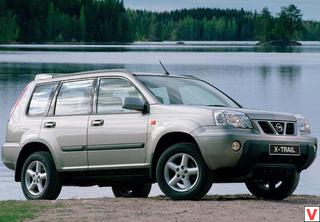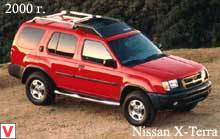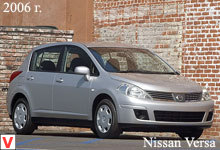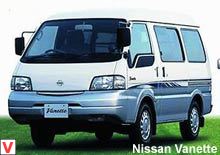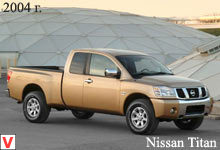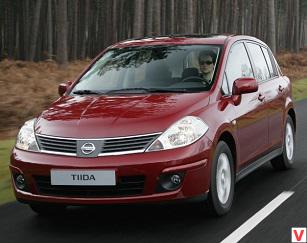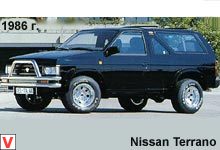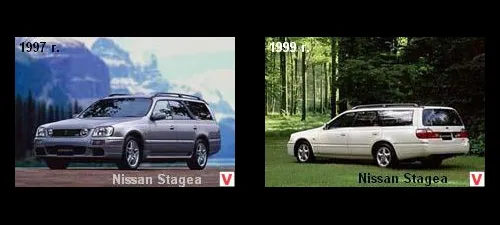
Rear-wheel drive wagon Stagea was developed by Nissan as a direct competitor to Subaru Heritage in the domestic market of Japan. Its production began in 1996. Three different versions of Stagea were produced: WC34 I (1996 - end of 1998), WC34 II (end of 1998 - 2001) and series M35 (from 2001 to 2007). Stagea 1996-1998 years of release had 17, and the years 1998-2001 - 19 versions, depending on the type of drive, type of power plant and equipment. The most powerful versions were called Aero. The body of the Stagea was carried by the carrier. The appearance of the car looked like a model 3R31 Skyline.
The dimensions of the Stagea WC34 were 4800/1755/1495 mm with a wheelbase of 2720 mm and a gauge of 1460/1515 mm, the minimum ground clearance is 145 mm. The curb weight of the machine is 1620 kg. Standard cabin equipment included velor upholstery, airbegs and power accessories. The most powerful version of AUTECH, also called the 260RS, had the following additional options: BREMBO brakes, a special exhaust system, a reinforced suspension, a special rear stabilizer, a particularly rigid body, an aerodynamic body kit and wheels with the original design.
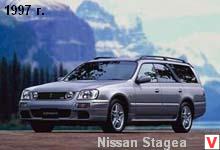
The interior was made in a sporty style, including leather upholstery and the execution of the steering wheel and gear lever. The Stagea WC34 installed 6-cylinder 24-valve gasoline engines RB20E SOHC (130 hp) and RB20DE DOHC (155 hp) with a volume of 2 liters, as well as 2.5-liter RB25DE DOHC (200 hp). ) and RB25DET DOHC IC turbo (231 hp). The speed of the car with the most powerful engine reached 225 km / h, which impressed the casual observers, for whom the Stagea looked like an ordinary family wagon.
Gasoline consumption of a car with an SR20DE 2 liter engine was 8/14/100 km, an RB25DE 2.5 liter - 9/15/100 km, an RB2 DET 2.5 liter - 9/16/100 km on the highway and in the urban cycle, respectively . In the transmission, mainly used rear-wheel drive with the ability to install a limited-slip differential as an option. Some cars were produced with permanent four-wheel drive, limited slip differential and the possibility of varying the torque on the front and rear wheels. The Stagea WC34 used 5-speed manual and 4-speed automatic transmissions. Steering rack type with power.

Independent suspension: front with transverse and triangular levers and rods, rear multi-link with longitudinal, transverse and diagonal levers. Both front and rear stabilizer bars were installed; Telescopic dampers with coil springs were also used. The brakes on the Stagea WC34 were fully ventilated discs.
ABS was supplied as standard. In the fall of 2001, the Stagea generation debuted on the FM platform with a body of the M35 type. In fact, it was a versatile version of the Skyline. In terms of overall dimensions (4785/1760/1510 mm) and the volume of the interior space of the passenger compartment, the Stagea came close to the European class E. The wheelbase was 2850 mm with a gauge of 1505/1505 mm. The curb weight is 1680 kg, and the maximum allowable is 1955 kg. Clearance - 150 mm.
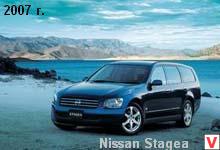
The luggage compartment - 500 l. Significantly changed the exterior of the car. An elongated grille with horizontal bars and large, rounded headlamps in combination with a nearly vertical line of the rear end gave the Stagea a distinctive, rather aggressive appearance. Three basic modifications were produced: the RS, RX and the all-wheel drive AR-X crossover with increased ground clearance and plastic protection of the wings and thresholds. There were a total of 11 variants of the Stagea M35. The 5-door, 5-seater station wagon remained as roomy and spacious.
The range of engines included a 2.5-liter engine VQ25DD V6 24V DOHC capacity of 215 hp and with a torque of 270 Nm, the same turbocharged power unit with an intercooler - VQ25DET (280 hp / 6400 rpm, 407 Nm / 3200 rpm), as well as a 3-liter VQ30DD V6, developing 260 hp and 324 Nm. The maximum speed of the car with any of the engines was electronically limited to 230 km / h. The power units were aggregated with a 5-speed manual or 4-speed automatic transmission.
Suspension and front, and behind was multi-link; braking system has not changed. The size of standard tires was 215/55 R17. The spacious Stagea station wagon, which had the dynamics and controllability of a sports car, had almost no analogues in the automotive market. However, as part of the Nissan cost-cutting program, the management of the company decided to complete the production of this model.
